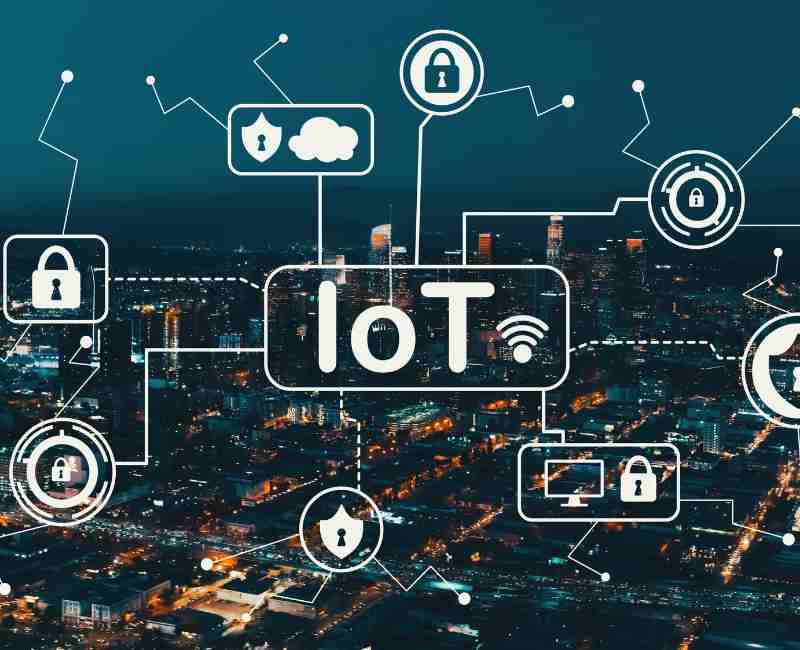The world we live in today is increasingly connected, with the Internet of Things (IoT) transforming how we interact with technology in our daily lives and within business operations. IoT devices, ranging from smart home appliances to sophisticated industrial sensors, are becoming integral components of our digital ecosystem. As these devices permeate various aspects of our lives, the importance of IoT security cannot be overstated. It stands as a critical pillar in safeguarding not just the devices themselves but the sensitive data they handle and the essential functions they perform.
One of the primary drivers of the IoT’s rapid expansion is its ability to enhance efficiency and convenience. Whether it’s in a smart home context or within complex industrial environments, IoT devices offer a level of interactivity and automation that was previously unattainable. However, this widespread integration brings with it a host of security challenges. The sheer diversity of IoT devices, coupled with their often-limited computing resources, makes implementing robust security measures a monumental challenge.
The complexity of IoT cybersecurity stems from several factors. First, there is the issue of scale. With billions of devices connected to the internet, each represents a potential entry point for malicious actors. Additionally, the heterogeneity of these devices means there is no one-size-fits-all solution for security. Different devices have different capabilities, operate in various environments, and require tailored security approaches. Moreover, many IoT devices continuously collect and transmit data, raising significant concerns regarding data privacy and protection.

Another layer of complexity is added by the need for these devices to seamlessly integrate and communicate within larger networks. This interconnectedness, while beneficial for efficiency and data analysis, also increases the risk of widespread system vulnerabilities. A single compromised device can potentially serve as a gateway to a larger network, putting an entire ecosystem at risk.
Furthermore, as IoT technology rapidly evolves, so do the cyber threats targeting these devices. Hackers are continually developing new methods to exploit vulnerabilities, whether for data theft, espionage, or sabotage. This dynamic landscape requires constant vigilance and adaptation from both manufacturers and end-users.
Understanding the IoT Security Landscape
1. IoT Devices and Their Vulnerabilities
In the realm of the Internet of Things (IoT), devices play a pivotal role in shaping our connected future. However, this ubiquity comes with a price: the vulnerability of these devices to various cyber threats. Understanding and mitigating these vulnerabilities is crucial to maintaining the integrity and security of our digital ecosystems.
When analyzing common vulnerabilities in IoT devices, several recurring themes emerge. First and foremost is the issue of inadequate authentication and authorization mechanisms. Many IoT devices lack robust methods to verify the identity of users or other connected devices, creating a vulnerability that malicious actors can exploit. Additionally, the often resource-constrained nature of these devices makes implementing strong encryption and security protocols a significant challenge.
The risk of data breaches looms large in the IoT landscape. With these devices handling sensitive information, from personal data on consumer devices to critical operational data in industrial settings, any breach can have far-reaching consequences. The interconnected nature of IoT devices means that a compromise in one area can potentially lead to a cascade of breaches throughout an entire network.
While the IoT’s primary goal is to improve processes and enhance efficiency, this very role introduces inherent security challenges. For instance, the continuous data exchange and real-time communication essential for IoT functionality create a larger attack surface for hackers. The diverse range of IoT devices, each with its own unique set of vulnerabilities, adds another layer of complexity to the security landscape.
The impact of new technology further complicates the security equation. As IoT devices become more advanced, incorporating cutting-edge technologies like artificial intelligence and machine learning, the attack vectors available to malicious actors also expand. The convergence of IoT with emerging technologies opens up new frontiers for cyber threats, requiring a proactive and adaptive security approach.
2. Risks and Consequences
The consequences of cyberattacks on IoT devices extend far beyond the immediate disruption of services. One of the most significant risks is the potential compromise of the customer experience. In consumer IoT, this could mean privacy invasion through unauthorized access to home security cameras or misuse of personal data from wearable devices. In industrial settings, cyber-attacks on critical infrastructure can lead to disruptions in operations, affecting not only the organization but also the wider community.
Observable risk factors in IoT systems serve as warning signs for potential vulnerabilities. Open ports, often left unprotected, can be exploited by hackers as entry points into the system. Ineffective security controls, such as weak passwords or a lack of encryption, expose IoT devices to unauthorized access and data manipulation.
The national implications of IoT security are particularly relevant, with a focus on challenges faced by the United States. As the integration of IoT devices becomes more pervasive, the potential for large-scale cyber incidents increases. This not only poses a threat to national security but also raises concerns about the resilience of critical infrastructure, including energy grids, transportation systems, and healthcare facilities.
3. Cybersecurity Solutions for IoT Devices
Current Threat Landscape
As technology advances, so too does the sophistication of cyber threats, and the Internet of Things (IoT) is no exception. The current threat landscape for IoT devices is characterized by a myriad of challenges, ranging from malicious actors seeking unauthorized access to harmful devices aimed at disrupting normal operations. Understanding and addressing these security concerns is paramount to ensuring the resilience of IoT ecosystems.
Identifying IoT security concerns
The first step in crafting effective cybersecurity solutions for IoT devices is to comprehensively identify the security concerns that permeate this landscape. Malicious actors, ranging from individual hackers to organized cybercriminal groups, pose a constant threat to the confidentiality, integrity, and availability of data processed by IoT devices. Their motives can vary from data theft for financial gain to industrial espionage and, in some cases, even sabotage.
In addition to human-driven threats, there is an emerging risk from harmful devices within the IoT ecosystem. These are compromised or manipulated devices that, once part of the network, can cause significant damage. This can include devices that have been physically tampered with, manipulated through malware, or even counterfeit devices designed to mimic legitimate ones.
The Necessity of Proactive Methods
To effectively counter these threats, a reactive approach is insufficient. The necessity of proactive methods for predicting and preventing attacks is evident. This involves anticipating potential vulnerabilities and developing preemptive strategies to mitigate risks before they can be exploited. Proactive cybersecurity measures encompass a range of activities, from threat intelligence and risk assessments to penetration testing and vulnerability management.
In the context of IoT, where devices may have limited resources, proactive methods also involve developing lightweight security protocols that do not compromise the functionality of the device. This includes robust authentication mechanisms, encryption of data in transit and at rest, and secure over-the-air (OTA) update processes to patch vulnerabilities promptly.
Continuous Monitoring Technologies
Continuous monitoring is a cornerstone of effective IoT cybersecurity. Given the dynamic nature of cyber threats, relying solely on static security measures is insufficient. The importance of continuous monitoring technologies becomes evident in their ability to detect anomalies and potential security breaches in real-time.
Continuous monitoring involves the use of advanced technologies such as intrusion detection systems (IDS), anomaly detection, and behavior analytics. These technologies create a proactive defense mechanism by identifying deviations from normal patterns of behavior in the IoT ecosystem. This allows for swift responses to potential threats, reducing the window of opportunity for malicious actors.
Effective Security Measures
Regular Security Audits and Management Systems
Regular Security Audits: Routine audits are crucial for identifying potential vulnerabilities within IoT ecosystems. These should include:
-
- Comprehensive evaluations of IoT devices and networks.
- Assessments of current security protocols and policies.
- Identification of any new or emerging threats.
Management Systems for IoT Security:
-
- Implement advanced management systems designed specifically for IoT security.
- These systems should enable centralized control and monitoring of all IoT devices.
- Incorporate real-time analytics for quick responses to security issues.
The Role of Senior Leadership
Strategy and Policy Development:
-
- Senior leadership must prioritize IoT security in organizational strategy.
- Develop and enforce robust cybersecurity policies.
Resource Allocation:
-
- Ensure adequate resources are allocated for IoT security initiatives.
- Invest in training and technology to stay ahead of emerging threats.
Data-Driven Methods and Tools
Advanced Analytical Tools:
-
- Utilize data analytics to monitor network traffic and detect anomalies.
- Implement AI and machine-learning tools for predictive threat analysis.
Continuous Improvement:
-
- Employ a data-driven approach for continuous refinement of security measures.
- Use insights gained from data analysis to inform decision-making processes.
Business Continuity and Incident Response
Strategies for Unusual Operations and Security Incidents
Incident Detection:
-
- Develop mechanisms to quickly identify unusual operations indicative of a security incident.
- Implement network monitoring tools and intrusion detection systems.
Incident Response Protocols:
-
- Establish clear incident response protocols for swift action.
- Include steps for containment, eradication, recovery, and post-incident analysis.
Importance of the Data-Driven Method
Maintaining Safe IoT Components:
-
- Utilize a data-driven approach to continuously assess and improve the safety of IoT components.
- Regularly update and patch IoT devices based on data analysis.
Adaptive Security Measures:
-
- Adapt security measures based on ongoing data analysis to address new and evolving threats.
Preparation for Intermittent Security Audits
Regular Internal Audits:
-
- Conduct internal security audits regularly to stay prepared for external audits.
- Focus on compliance with industry standards and regulations.
Documentation and Reporting:
-
- Maintain thorough documentation of security policies, procedures, and audit results.
- Ensure transparency and accountability in security practices.
Implementing Cybersecurity Best Practices
Organizational Approach to IoT Security
Establishing Primary Goals:
-
- Clearly define the primary goals for IoT security within the organization.
- Align these goals with broader business objectives to ensure comprehensive coverage.
Integration into Cybersecurity Strategies:
-
- Acknowledge the challenge of integrating IoT security into broader cybersecurity strategies.
- Identify and bridge gaps between traditional IT security and IoT-specific requirements.
Senior Leadership Involvement:
-
- Recognize the necessity of senior leadership involvement in IoT cybersecurity efforts.
- Ensure that leaders champion and prioritize IoT security initiatives.
Table: Primary Goals for IoT Security
| Goal | Description |
|---|---|
| Device Integrity | Ensure the integrity of IoT devices to prevent tampering or unauthorized access. |
| Data Confidentiality | Implement measures to protect sensitive data transmitted and processed by IoT devices. |
| Continuous Monitoring | Establish systems for real-time monitoring to detect and respond to security threats promptly. |
| Compliance and Regulations | Ensure adherence to industry regulations and compliance standards relevant to IoT security. |
Case Studies and Examples
Successful IoT Security Implementations
Industry Expert Examples:
-
- Showcase examples of successful IoT security implementations by recognized cybersecurity experts.
- Highlight specific strategies, technologies, or frameworks that led to success.
Table: Lessons Learned from IoT Security Breaches
| Lesson | Description |
|---|---|
| Inadequate Authentication | Highlight the risks associated with weak authentication mechanisms on IoT devices. |
| Insufficient Encryption | Discuss the consequences of inadequate data encryption in IoT communication. |
| Lack of Regular Updates | Emphasize the importance of timely software updates to patch vulnerabilities. |
| Limited User Awareness | Showcase incidents where user awareness played a crucial role in preventing breaches. |
Importance of a Proactive Approach:
-
- Explore lessons learned from past IoT security breaches to underscore the importance of a proactive approach.
- Analyze how organizations can leverage these lessons to enhance their own cybersecurity posture.
Highlighting Best Practices:
-
- Provide a comprehensive overview of best practices in IoT security based on successful case studies.
- Include aspects such as continuous monitoring, threat intelligence integration, and secure software development.
- More Post: Cybersecurity Tips for Remote Workers: Enhancing Security in Remote Work Environments
- More Post: What is two-factor authentication and why is it important?
Key Takeaways
- The Critical Importance of IoT Security
- In the era of rapidly advancing technology, the integration of Internet of Things (IoT) devices has become pervasive across various sectors. The critical importance of IoT security cannot be overstated, considering the potential risks associated with these interconnected devices. Securing IoT ecosystems is not just about protecting data; it’s about safeguarding the functionality of devices that have become integral to our daily lives and essential business operations.
Table: Key Considerations in IoT Security
| Consideration | Description |
|---|---|
| Data Protection | Safeguarding sensitive information processed by IoT devices. |
| Device Functionality | Ensuring the uninterrupted operation of IoT devices. |
| User Privacy | Respecting and protecting the privacy of individuals interacting with IoT systems. |
| Business Continuity | Mitigating the impact of security incidents on overall operations. |
Continuous Improvement and Adaptation in IoT Cybersecurity
Recognizing that the landscape of cyber threats is ever-evolving, the key to effective IoT security lies in continuous improvement and adaptation. Static security measures are insufficient in the face of dynamic and sophisticated threats. Organizations must commit to regularly updating their security protocols, staying abreast of emerging threats, and adapting strategies to address new vulnerabilities. This proactive approach is vital to ensuring the long-term resilience of IoT ecosystems.
Table: Strategies for Continuous Improvement
| Strategy | Description |
|---|---|
| Regular Updates | Timely implementation of security patches and firmware updates. |
| Threat Intelligence Integration | Incorporating real-time threat intelligence to anticipate new attack vectors. |
| User Education | Providing ongoing education to users about security best practices. |
| Collaboration with Experts | Engaging with cybersecurity experts and organizations for insights and guidance. |
The Future Landscape of IoT Security and Its Challenges
Looking ahead, the future landscape of IoT security poses both opportunities and challenges. As technology continues to evolve, the number and complexity of IoT devices are expected to increase exponentially. This growth brings not only enhanced capabilities but also new attack surfaces for malicious actors. The challenges lie in developing security measures that can keep pace with technological advancements and anticipating the unforeseen risks that may arise.
Table: Challenges in Future IoT Security
| Challenge | Description |
|---|---|
| Device Diversity | Managing security across a diverse range of IoT devices with varying capabilities. |
| Evolving Threat Landscape | Adapting to new and sophisticated cyber threats targeting IoT ecosystems. |
| Regulatory Compliance | Navigating the evolving landscape of regulations and compliance standards. |
| Privacy Concerns | Balancing the benefits of IoT with the protection of user privacy. |
FAQ
What are the most common security risks associated with IoT devices?
IoT devices are vulnerable to various risks, including unauthorized access, data breaches, and malware attacks. The interconnected nature of these devices can also lead to a compromised network if one device is breached.
How do IoT devices enhance the customer experience and operational efficiency?
IoT devices play a crucial role in enhancing the customer experience by providing personalized and efficient services. In business operations, they improve efficiency through automation, real-time monitoring, and data analytics, leading to informed decision-making.
Why are regular updates and monitoring vital for IoT security?
Regular updates are crucial, as they often include patches for newly discovered vulnerabilities. Continuous monitoring helps in the early detection of any unusual activities or potential threats, enabling a timely response to prevent cyberattacks.
- More Post: Understanding the Role of Firewalls in Network Security
- More Post: How do you create strong and secure passwords?
Conclusion
As we delve into an increasingly interconnected world, the importance of cybersecurity in protecting IoT devices from cyber threats becomes more paramount. The vulnerabilities inherent in IoT devices pose risks not only to data and privacy but also to the functional integrity of the devices themselves.
A comprehensive and continuous approach to IoT cybersecurity is essential. This includes regular updates, continuous monitoring, and adopting proactive strategies to anticipate and mitigate potential risks. It’s about creating a dynamic and resilient security framework that evolves with emerging threats.
Finally, it is imperative for organizations to prioritize IoT security as a core component of their operational strategies. The integration of IoT devices is not just a technological advancement but a transformation that requires a robust cybersecurity mindset. Prioritizing IoT security is not only about safeguarding assets but also about ensuring trust, reliability, and sustainability in the digital era.
In conclusion, as IoT devices continue to permeate every aspect of personal and professional environments, understanding and implementing robust cybersecurity measures becomes a necessity. By embracing a vigilant, informed, and proactive approach, we can navigate the challenges of IoT security and harness its full potential safely and effectively.






